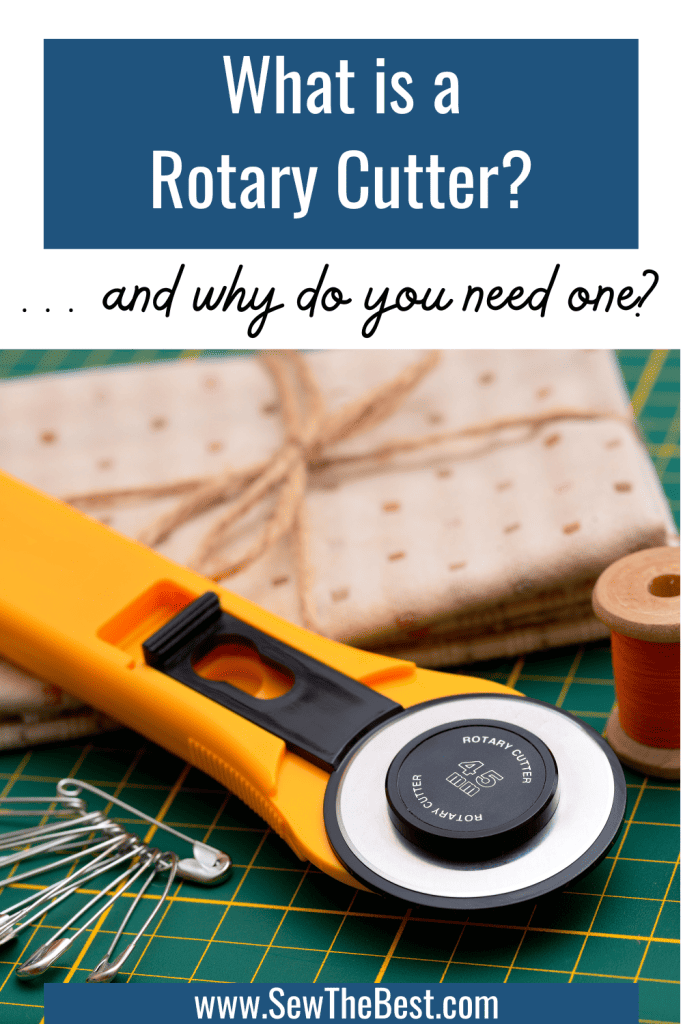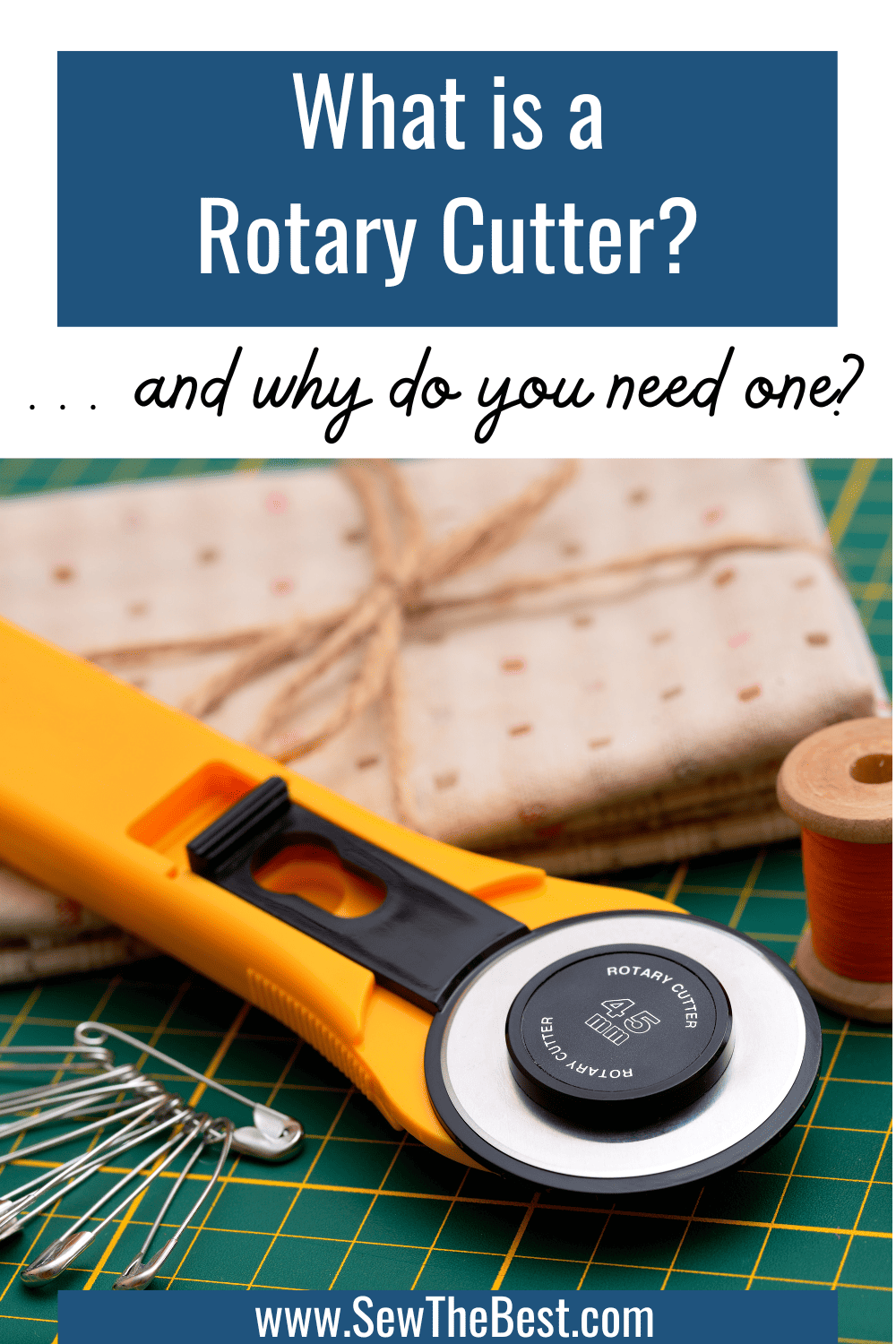Welcome to our informative guide on rotary cutters! If you’re passionate about sewing and crafting, a rotary cutter is a fantastic tool that can make your projects easier and more precise. In this article, we’ll explore what a rotary cutter is, its significance in sewing projects, and why you should consider using one. Whether you’re a seasoned sewing enthusiast or just starting, understanding the benefits of a rotary cutter can elevate your skills and bring joy to your creative endeavors. Let’s dive in and discover the world of rotary cutters together!
Before we get started with what a rotary cutter is, let’s talk about why you would even want to use one. A rotary cutter allows you to quickly and easily make highly precise cuts on your fabric. They zip along the fabric much faster than scissors can. Rotary cutters are also great for cutting through multiple layers of fabric at the same time. So if you are making multiple copies of a piece – say fat quarters or a pair of pants legs, rotary cutters can make life easier by allowing you to cut once and have multiple identical pieces.

If you’re in a hurry (or just curious!) –
✅ Check deals on our favorite rotary cutter starter kit!


What is a Rotary Cutter?
A rotary cutter is a versatile and essential tool used in sewing and crafting projects. Its primary purpose is to enable quick and precise cutting of various materials, such as fabric, paper, and leather. This handy tool consists of a sharp, circular blade, usually made of stainless steel, attached to a comfortable handle. The blade is safely housed within the cutter’s protective head. Rotary cutters come in various sizes, with the most common size having a blade diameter of 45mm, which is favored by many sewing enthusiasts. With its efficient design and ease of use, a rotary cutter offers exceptional control, making it ideal for achieving clean and accurate cuts for your creative endeavors.
Having a sharp blade is crucial for a rotary cutter. A sharp blade ensures clean and effortless cuts, reducing the risk of fabric distortion or fraying. Whe nyour blade is dull, you need to use more pressure to cut through your fabric. This increases the risk that you’ll accidentally cut yourself or something other than your fabric. It can also damage whatever you have behind your fabric. Having such a sharp blade also means you need to use caution while handling the cutter. Always keep the blade covered when not in use and store it safely in a designated holder. When changing the blade, follow the manufacturer’s instructions carefully to avoid accidents. Additionally, keep the rotary cutter out of reach of children and use it only on appropriate cutting surfaces to avoid injury and maintain the blade’s sharpness.
Speaking of appropriate cutting surfaces, to protect your work surface it is essential to use a self-healing cutting mat underneath the fabric. The cutting mat not only provides a smooth surface for the rotary cutter to glide on but also prevents the blade from dulling quickly. Additionally, using clear acrylic rulers or templates can help ensure precise measurements and straight cuts, as they allow you to see through to the fabric beneath. By utilizing cutting mats and rulers, you’ll enhance the accuracy and safety of your cutting process, leading to impeccable results in your sewing and crafting projects.
Want more information about cutting mats? Check out our post What is a Self Healing Cutting Mat?
While rotary cutters are fantastic tools, beginners may find them tricky. The most common mistake is applying too much pressure while cutting, which can lead to uneven edges or even accidents. It’s essential to maintain a steady but gentle pressure when using the rotary cutter. Let the blade do the cutting, not your pressure. Another mistake is not changing the blade when it becomes dull. A dull blade can cause jagged cuts, require you to use more pressure to cut, and put unnecessary strain on the fabric. Be sure to replace the blade regularly for optimal results.
By understanding the purpose, design, and safety considerations of a rotary cutter, along with utilizing cutting mats and rulers properly, you can make the most of this indispensable tool for your sewing and crafting endeavors. Avoiding common mistakes will help ensure that your rotary cutter consistently delivers precise and professional results.
FAQ
What is a rotary cutter used for?
A rotary cutter is primarily used for cutting various materials, such as fabric, paper, leather, and vinyl, with precision and efficiency. It is a valuable tool in sewing and crafting projects, enabling clean and accurate cuts, especially when dealing with multiple layers of fabric. Rotary cutters are commonly used for cutting out pattern pieces, quilting blocks, and other sewing tasks that require straight lines and smooth edges.
Is a pizza cutter the same as a rotary cutter?
While both a pizza cutter and a rotary cutter have a circular blade design, they serve different purposes and are not the same. A pizza cutter is specifically designed for cutting pizza into slices, with a sharp, wheel-like blade. On the other hand, a rotary cutter is a sewing and crafting tool with a circular blade used for precise and controlled cutting of various materials like fabric, paper, and more. The blades of rotary cutters are typically sharper and more suitable for detailed and accurate cutting in sewing and crafting projects.
Is there a difference in rotary cutter blades?
Yes, there are different types of rotary cutter blades designed for various cutting purposes. The most common rotary cutter blade is the straight-edge blade, suitable for standard cutting tasks on fabric and other materials. Additionally, there are specialty blades, such as wavy blades for decorative edges, pinking blades for reducing fabric fraying, and perforating blades for creating dotted lines. Rotary cutter blades also come in various sizes, ranging from 18mm to 60mm in diameter. Smaller blades, like 18mm and 28mm, are ideal for intricate cutting, while larger blades, like 45mm and 60mm, are favored for cutting through multiple layers and thicker materials. Choosing the right type and size of rotary cutter blade based on your specific sewing or crafting needs will help you achieve the best results in your projects. Always follow the manufacturer’s guidelines for blade replacement and safety precautions to ensure a smooth and enjoyable cutting experience.
What is the advantage of using a rotary cutter over traditional scissors for sewing projects?
Rotary cutters offer several advantages over traditional scissors. They provide smoother and more precise cuts, especially when dealing with multiple layers of fabric. Additionally, rotary cutters save time and effort, making them ideal for cutting out pattern pieces or quilt blocks quickly and accurately.
How do I choose the right size of a rotary cutter for my sewing projects?
The most common size of a rotary cutter used in sewing is 45mm, which works well for a wide range of tasks. If you work on smaller or more intricate projects, you may consider a smaller blade size, such as 28mm, while a larger blade, like 60mm, is suitable for cutting through thicker materials and multiple layers.
How often should I change the blade on my rotary cutter?
The frequency of blade changes depends on how often you use the rotary cutter and the type of materials you cut. Generally, you should change the blade when it becomes dull or shows signs of wear, as a sharp blade ensures cleaner cuts and reduces strain on the fabric.
What safety precautions should I take when using a rotary cutter?
Safety is essential when working with rotary cutters. Always keep the blade covered when not in use and store the cutter in a safe place out of children’s reach. Be cautious while cutting, using steady and controlled pressure, and avoid cutting towards your body. Consider using a cutting mat to protect your work surface and always follow the manufacturer’s safety guidelines.
Can I use a rotary cutter on materials other than fabric?
Yes, rotary cutters are versatile tools and can be used on various materials, such as paper, leather, and vinyl. Ensure you have the appropriate blade for the material you intend to cut to achieve the best results.
Can left-handed individuals use rotary cutters comfortably?
Yes, many rotary cutters are designed for both right-handed and left-handed users. Look for rotary cutters with an ambidextrous handle or models explicitly designed for left-handed individuals to ensure a comfortable cutting experience.
Are rotary cutters suitable for beginners in sewing?
Yes, rotary cutters can be suitable for beginners in sewing who are willing to take their time and be cautious when learning the new tool. While rotary cutters are efficient and precise, they do require some practice to use safely and effectively. If you’re a beginner, take your time to familiarize yourself with the cutter’s handling and follow safety guidelines. With practice, you’ll find that rotary cutters can significantly enhance your sewing projects.
Do I need a cutting mat when using a rotary cutter?
Yes, using a cutting mat is highly recommended when using a rotary cutter. A self-healing cutting mat provides a smooth surface for the blade to glide on, protects your work surface from damage, and extends the life of your rotary cutter blade.
Can I use a rotary cutter to cut curves or intricate shapes?
Yes, you can use a rotary cutter to cut gentle curves, but not intricate shapes. While rotary cutters excel at cutting straight lines and gentle curves, cutting intricate shapes might be challenging. For complex designs, consider using scissors or fabric shears, or opt for specialty rotary cutters that are designed specifically for cutting curves.
Can I sharpen rotary cutter blades once they become dull?
No, rotary cutter blades are not typically designed to be sharpened. Once a blade becomes dull, it’s best to replace it with a new one for optimal cutting performance.
Summary
In conclusion, rotary cutters are indispensable tools that bring precision and efficiency to sewing and crafting projects. With their ability to cut multiple layers of fabric at once and the aid of cutting mats and rulers for enhanced accuracy, rotary cutters offer several advantages over traditional scissors. Whether you are a seasoned sewing enthusiast or just starting, exploring the world of sewing and crafting with rotary cutters opens up a realm of possibilities, allowing you to bring your creative visions to life with ease and precision. Embrace the joy of crafting with these versatile tools and let your imagination soar as you create beautiful and intricate designs. Happy sewing and crafting!
Related Posts:
- Want to know more about rotary cutter mats? Check out our post What is a Self Healing Cutting Mat?
- Looking to buy a rotary cutter? Check out our post Best Fabric Rotary Cutter and Mat [Review and Compare]
- Looking for more beginner sewer tools? Check out the The Best Basic Sewing Tools for Beginner Sewers
